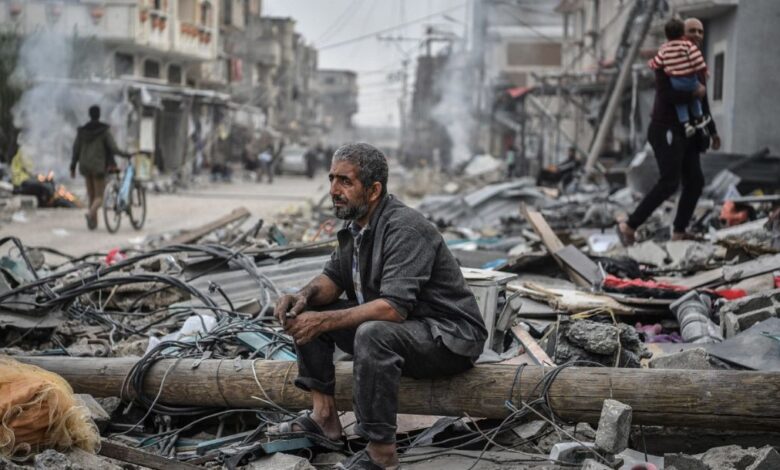What’s happening in Gaza? A desperate humanitarian crisis

October 2025 ceasefire agreement
A ceasefire agreement was reached on 10 October 2025, allowing the safe return of 20 hostages and an increase of aid into Gaza.
On 13 October, the ICRC facilitated the safe return of 20 hostages to Israeli authorities and 1,808 Palestinian detainees to Gaza and the West Bank. A total of 1,718 detainees and 250 prisoners were released that day, with the ICRC conducting pre-release interviews for all. The transfer of the remains of deceased hostages and Palestinian detainees is ongoing.
Learn more about how the Red Cross has helped hostages
It is vital this ceasefire agreement is upheld. We need to see a lasting commitment to stability and recovery, with all parties ensuring the protection of civilians, aid workers, and of medical facilities in Gaza.
The ceasefire agreement has allowed some aid to enter Gaza, but restrictions remain. Both the Egyptian Red Crescent Society and Jordan National Red Crescent Society have fully stocked and operational warehouses which are ready to increase aid deliveries into Gaza.
The Egyptian Red Crescent Society confirmed on 12 October that 400 trucks carrying more than 9,000 tonnes of aid had crossed the border into Gaza. This includes flour, fresh bread, baby milk, tents, medical supplies and medicines. The Jordan National Red Crescent Society also has a full warehouse and is ready to deliver aid into Gaza when conditions allow. Five trucks of aid from the Turkish Red Crescent also crossed the border into Gaza.
A catastrophic humanitarian disaster
Despite the ceasefire, the humanitarian situation in Gaza remains catastrophic. Every day has been a fight for survival for the people in Gaza.
The collapse of the health system, coupled with continued fighting and the complete suspension of aid delivery for 11 weeks, led to an unprecedented rise in unmet humanitarian and medical needs.
Severe malnutrition is only getting worse
Months without aid pushed malnutrition in Gaza to catastrophic levels, with children, pregnant women, and the elderly suffering the most. Medical teams are working tirelessly to provide emergency nutrition support, essential food supplements, and basic medical care.
“This is not just a crisis for today — it’s a crisis for generations to come,” said Naziha El Moussaoui, food security, nutrition and livelihoods advisor at the British Red Cross. “Malnutrition weakens the immune system, leaving people—especially the most vulnerable—unable to fight off disease and infection. The long-term effects will echo far into the future. Without immediate and sustained humanitarian assistance, we risk impacting not only this generation but the next. With chronic malnutrition comes longer-term health impacts which can be irreversible in children. We need a sustained flood of support — not just to save lives today, but to safeguard the future of entire communities.”
Two years of conflict have devastated Gaza’s critical infrastructure, including services vital for electricity, clean water, sanitation, and healthcare. These disruptions have deepened food insecurity, causing severe shortages of essential supplies such as flour, sugar, proteins, and carbohydrates, leaving many without the nutrients necessary to survive.
The worsening crisis has pushed medical facilities beyond capacity. Field hospitals like the Red Cross facility in Rafah are overwhelmed, facing rising numbers of emergency cases alongside malnutrition treatments.
Despite the immense pressure, medical teams continue to provide vital nutrition and care, supported by the International Red Cross and Red Crescent Movement as they respond to the escalating humanitarian emergency.
Increase in mass-casualty events since the opening of new aid distribution sites in May 2025
The Red Cross Field Hospital in Rafah saw an unprecedented rise in patients, treating over 3,400 in May alone – the vast majority caused by gunfire. That’s more than 2024 in total.
Since the launch of new aid distribution sites, there were more than 21 separate mass casualty events with toddlers, teenagers, the elderly and mothers among the wounded.
The scale and frequency of these incidents overwhelmed the 60-bed field hospital that is now running beyond maximum capacity daily. But, despite the chaos and overwhelming demand, the surgical teams continue to operate tirelessly.
“In the previous rotations, we would work in the operating theatre between eight-10 cases. Right now, we are working on 30-40 cases per day which is a massive difference just in terms of workload,” operating theatre nurse Haitam al-Hasan said in the summer.
“We have people screaming, rushing, trying to be the first in the line because, of course, everybody wants to be treated first. We have a variety of injuries, mostly complex injuries, blast injuries, but mainly gunshot injuries.”
Additional support teams from the International Red Cross and Red Crescent Movement have also been deployed to help manage the influx and deliver lifesaving care under unimaginable pressure.
Donate to the Gaza Crisis Appeal
Timeline of the Gaza crisis
- October 2023: attack in Israel, escalation of conflict in Gaza, Red Cross appeal launched.
- May 2024: field hospital set up in Rafah.
- September 2024: hundreds killed as conflict escalates in Lebanon.
- January 2025: ceasefire allows for delivery of aid and hostage releases.
- March 2025: aid delivery suspended.
- June 2025: field hospital set up in Al-Mawasi.
- July 2025: malnutrition reaches catastrophic levels in Gaza.
- October 2025: ceasefire agreement reached.
Source link




